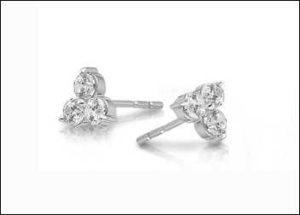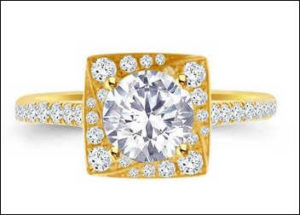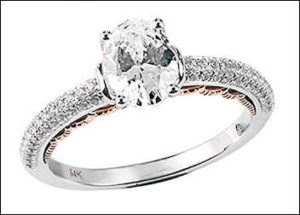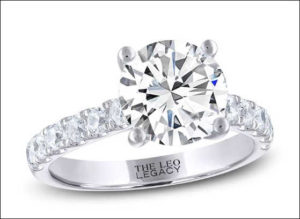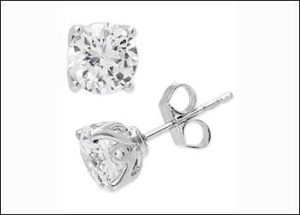Bigger, Better for Money Drives Lab-Grown Sales
Consumers are coming into stores and asking about lab-grown diamonds.
They appear to have done so during the holidays, as initial post-sales reports identify lab-grown diamonds a product that elevated revenues for the season.
Diamond jewelry in general was hailed a bestseller for the season, but it speaks volumes when Rapaport Diamond Report’s lead headline for the New Year proclaims that “Lab-Grown Drives ‘Phenomenal’ Sales.”
What’s driving these phenomenal sales has borne out what consumers have been saying in market surveys the past few years: they like the choice lab-grown diamonds present to get a bigger, better diamond for their money.
“Consumers come in with a certain budget and aspirations in mind, and when compared to a mined stone, the lab-grown diamond gives them an option,” says Cora Lee Colaizzi, director of marketing and catalogs and senior merchandiser for Quality Gold (QG), Fairfield, Ohio.
Bridal market consumers are choosing lab-grown diamonds for an engagement ring stone in increasing numbers. A 2019 report published by the International Grown Diamond Association (IGDA), and conducted by MVI Marketing, found that 66% of Millennials actively shopping for an engagement ring would consider a lab-grown diamond, and 23% would buy a ring set with lab-grown diamond.
The main purchase driver is getting a bigger, better-quality lab-grown diamond for the same price as a smaller mined diamond. This sentiment has proven true in recent research conducted by MVI and others.
Bridal Base
Driven by rising consumer demand and the opportunity to restore healthy margins in the supply chain, engagement rings, a category that had been stripped of profitability in recent years, has become the foundation for lab-grown diamonds in the U.S. market, which represents about 80% of world consumption.
While natural-mined diamonds continue to be the most popular type of engagement stone, nearly one in four engagement rings in 2021 featured a man-made center, up 11% in the past two years, cites The Knot, based on a survey conducted in November of 5,000 U.S. couples who became engaged between January and November 2021.
The category has grown in the last three years, following the Federal Trade Commission (FTC) declaration in 2018 that a diamond is a diamond. That’s when major brands like De Beers and Signet Jewelers entered the space, further validating the product.
Although a majority of shoppers at its stores are still buying natural-mined diamonds, Signet expanded its man-made bridal jewelry selection in 2021, including the new LEO LEGACY lab-created diamond engagement ring and wedding band collection, produced by Leo Schachter for Kay. Also, TRUE by Vera Wang LOVE, manufactured by SDC Designs for Zales, introduced engagement ring styles with lab-grown diamonds.
Jamie Singleton, president at Signet Jewelers, which owns Zales, Kay Jewelers and Jared, told CNN Business in December that demand is growing for lab-created diamonds. “This is very Millennial-based, and frankly they are the demographic that represents most of the shoppers in the bridal category. The lesser cost of a lab-created diamond allows couples to buy a larger stone.”
Price & Value
When analyzing the wholesale and retail prices of unbranded man-made and natural diamonds, diamond industry analyst Paul Zimnisky found the retail gross margin of lab-grown diamonds in popular carat-sizes is as much as 1.8 times that of natural diamonds. He says retailers have been protective of their margin.
Recent diamond market analysis by Bain & Company cites the retail price of a 1-carat, G color, VS-clarity lab-created diamond fell to only 35% of an equivalent mined diamond in 2020; in 2019 and 2018 this figure was 50%, and in 2017 it was 65%. Prices have stabilized and will continue to as consumer markets and luxury brands in Europe, China and India test the waters, says Marty Hurwitz, CEO of MVI Marketing.
Although synthetic diamonds are created in a lab, Hurwitz says that they are not easy or cheap to grow. For lab-grown diamonds to reach 15% of the diamond market, which Bain predicts could happen by 2030, an enormous amount of stones would need to be produced, and supply is currently not meeting demand. Among the challenges is a shortage of scientist’s savvy in the technology to grow diamonds of consistent size and quality, and a shortage in components used for diamond growing chambers.
The long-term value of lab-grown diamonds has yet to be determined, says Colaizzi. “There is a value. What the future holds, it is too early to predict. The pros and cons should continue to be discussed so consumers are educated.”
Making the Cut
Diamond cut grade is becoming an important topic for jewelers considering lab-grown diamonds. “Questions have moved from ‘is this real’ to ‘how do I buy the best’. What really makes a stone significant has a lot to do with cut, which is why Quality Gold offers GCAL 8X certification for both natural and lab-grown diamonds. As the ultimate diamond cut grade, it’s a differentiator for jewelers.”
Diamond innovation is what Leo Schachter Diamonds is known for. Brands like THE LEO diamond, cut visibly brighter using patented technology strategically placing additional facets to maximize light return (66 facets). It brought this innovation to the First Light Diamond several years ago and recently launched the new LEO LEGACY brand of lab-created diamond engagement rings for Kay Jewelers.
“We are very much on the forefront of creating innovative, patent-protected products that can bring our retail partners increasing sales and higher profit margins,” says Lenny Kramer for Leo Schachter Diamonds in New York, which has proven expertise in branded diamond product development for a variety of leading jewelers worldwide for more than two decades now.
While lab-grown diamonds are not the main focus for his retail customers, especially high-end independents that comprise the bulk of LSD’s base, Kramer sees the potential of the category and expects it will continue to grow in 2022. “Lab-grown diamonds afford the opportunity for the consumer to expand upon their choices yielding the retailer a potentially higher margin. Given this opportunity, especially in our industry, we are responding by offering a quality product that stays true to our brand.” Thus, the LEO LEGACY is billed, “the first lab-created diamond worthy of THE LEO name.”
Fashion Up
Retailers are buying a considerable amount of loose lab-grown diamonds to use in custom designs, reports Colaizzi, who spoke about the lab-grown diamond market in a podcast for The Plumb Club. But even more have been asking for finished lines set with lab-grown diamonds, and also paired with lab-grown color stones. “Retailers would not be doing that if consumers were not asking for it.”
While engagement ring center stones have been the mainstay for lab-grown diamonds so far, most retailers envision rapid expansion into diamond jewelry basics — center stone-centric pieces like studs, solitaire pendants, and line bracelets, finds The Plumb Club Insights 2021 research. Most jewelers who have established a bridal business in lab-grown diamonds are selling these basics already, with fashion jewelry now emerging.
Consumers appear ready to embrace fashion jewelry made with lab-grown diamonds. Those actively shopping for fashion diamond jewelry expressed a high level of interest in lab-grown diamonds. TPC Insights 2021 finds that of the more than 1,000 U.S. jewelry consumers surveyed, 65% would consider a lab-grown diamond engagement ring, but even more, at 83% would like lab-grown diamond fashion jewelry. Lower price and size differential are the top determinants.
Sustainable Factor
The Knot’s recent survey attributes the popularity of lab-grown diamonds to the eco-conscious mindset of Millennial consumers and a subset of GenZ-ers, based on their responses. We see in De Beers eighth annual Diamond Insight Report that jewelry ranked third, after food and clothing, as the category most frequently purchased on the basis of sustainability considerations.
Transparency and traceability are becoming central to ethics and sustainability for consumers, who want to ensure their jewelry, like their olive oil and coffee beans, come from a “good” place.
Colaizzi notes that many consumers have a real appreciation for the innovative technology used to produce lab-grown diamonds. “They love the fact that in seven to 20 days 1 carat can be created in the correct conditions versus millions of years in the earth,” she describes. Younger consumers also prefer that tons of earth is not displaced to find their diamond; that lab-grown diamonds are naturally conflict free; and that lab-grown diamonds can be certified using the same quality-analysis used to certify natural mined stones.
Just as mined diamonds have their challenges to overcome on the path to sustainability, so do lab-grown producers when it comes to the enormous amount of energy needed to make a diamond, notes Mark Hanna, CMO for Richline Group based in New York City, which is involved in both natural and lab-grown diamonds. How are they mitigating that with renewable energy?
Some lab-grown diamond producers are attaining SCS Certification for Sustainable Diamonds, which assesses Environmental, Social and Governance (ESG) standards. Hanna notes that the environmental criteria, includes the energy a company takes in and the waste it discharges, the resources it needs, and the consequences for living beings as a result.
The FTC Green Guides is a good resource, says Hanna, to understand what is and is not acceptable for green claims when advertising both natural mined and lab-grown diamonds (https://www.ftc.gov/news-events/media-resources/truth-advertising/green-guides).
